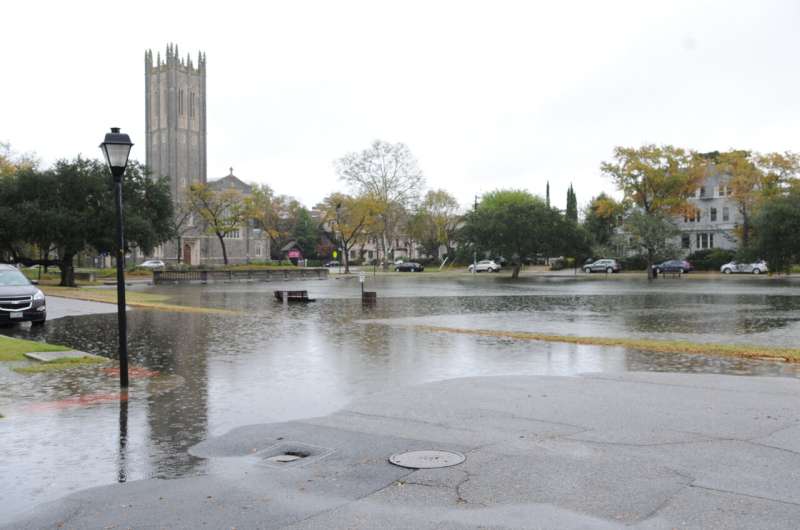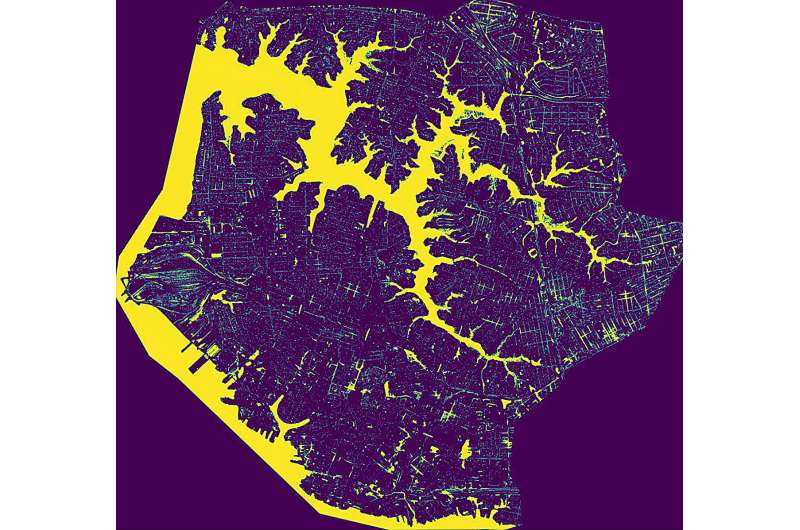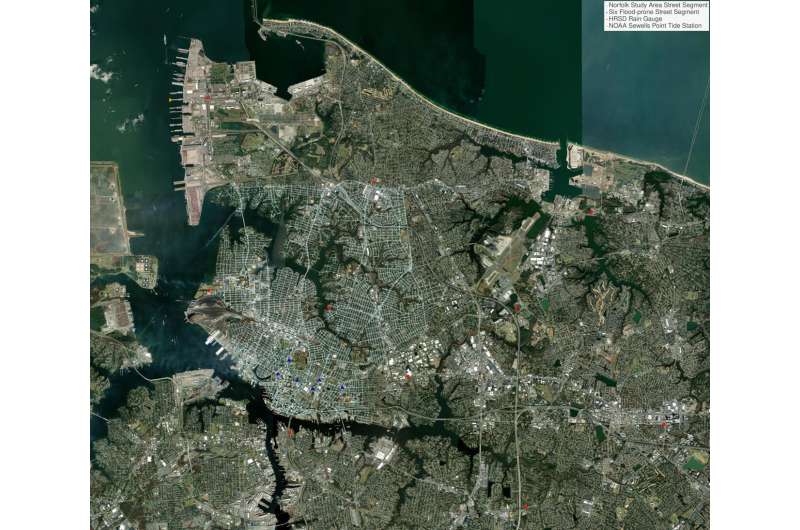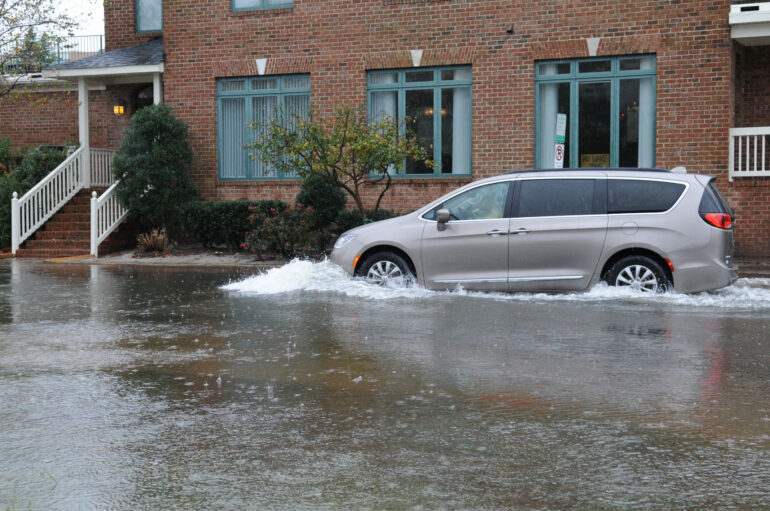Getting around on a rainy day often involves dodging puddles—or sloshing through them. But during downpours, shallow pools can quickly become roadway ponds that cripple transportation, threaten safety and undermine emergency response.
This is especially true in Virginia’s Hampton Roads area. Named after one of the many bodies of water that link its cities and counties, the coastal Virginia region is no stranger to flooding from rivers, seas or skies.
For decades, local officials have explored data-driven ways to combat extreme weather, getting help from researchers along the way. Now, the U.S. Department of Energy’s Thomas Jefferson National Accelerator Facility is adding its own advanced computing expertise to benefit the larger community.
Scientists from Jefferson Lab, Old Dominion University and the University of Virginia recently conducted a study comparing deep learning models of street-scale flooding in the City of Norfolk with previous machine learning and physics-based simulations. Their work, published in the journal Machine Learning with Applications, uses data from roughly 17,000 street segments covering 400-plus miles of roadway to weigh the strengths and weaknesses of surrogate models.
One of those strengths is speed. While physics-based simulations can take several hours to run, machine learning models can perform similar calculations in a matter of seconds. The research could help forecasters more swiftly predict which sections of Norfolk’s transportation grid will be underwater.
“Flooding is a transportation, health, and emergency management problem,” said Jefferson Lab Data Scientist Diana McSpadden. “If a rainfall event is expected, you need to know where the high water will be. For urban decision-makers, it is particularly important to figure these things out quickly.”
The study was carried out as part of the Joint Institute on Advanced Computing for Environmental Studies (ACES), a unique partnership launched by Jefferson Lab and ODU this past November.

An area of Norfolk, Virginia, is flooded during a rainfall event. © Old Dominion University Photography
The ‘Mermaid City’
Hampton Roads is a magnet for maritime activity and a playground for boaters, beachgoers and anglers alike. In fact, the region’s namesake is its deep and bustling harbor—a roadstead in nautical terms.
Here, hundreds of miles of shoreline provide easy access to rivers, creeks, lakes, the Atlantic Ocean and the Chesapeake Bay. But all that water can pose a threat.
Hampton Roads has seen its share of coastal flooding caused by tidal events, river swells, storm surges, sea level rise, or any combination of those. A generally flat landscape and low elevation also make the region particularly vulnerable to flooding from heavy rainfall.
“The definition of nuisance flooding is something I became fairly obsessed with,” McSpadden said. “It sometimes seems to refer to sunny-day, tidal flooding, but it can also be caused by rainfall and storm surge, or a combination of events.”
Flooding in Hampton Roads is pronounced in Norfolk, home to ODU and just across the roadstead from Jefferson Lab. Norfolk is Virginia’s second-most populous city with about 230,000 residents. It features the Port of Virginia international shipping gateway, the world’s largest navy base, a vibrant downtown waterfront, and a popular beach along the Chesapeake Bay.
Nicknamed the “Mermaid City,” Norfolk’s history of resilience results from the countless storms weathered since the city’s incorporation in 1705—when Virginia was an English colony. Today, Norfolk is among the U.S. cities most vulnerable to coastal flooding, and researchers say it could get worse.
According to an ODU-led paper published in the journal Geophysical Research Letters, nuisance flooding in Norfolk has increased 325% since 1960. The study says it will become even more frequent, “with a potential for well over 200 flood events in the year 2049.”
“Nuisance flooding is in contrast to extreme events, and most importantly is becoming more common due to sea-level rise,” McSpadden said. “And the term ‘nuisance’ will be less and less applicable as these events become more frequent, because there will be less recovery time between flooding events.”

This figure illustrates the predicted water depth obtained using ACES research using a Fourier Neural Operator (FNO) model which is able to predict over the continuous spatial domain at a 2.5m x 2.5m spatial resolution in the Norfolk, Virginia study area. The minimum predicted water depth is 0m (purple), indicating areas where flooding is not predicted to occur given the environmental conditions. In contrast, the maximum predicted water depth reaches approximately 5m (yellow), as seen in the Elizabeth River. © Jefferson Lab
Unnavigable waters
Travel through Norfolk on a rainy day, and there’s a good chance you’ll encounter a submerged road. This can call for crisscrossing through side streets, much like navigating a “Pac-Man” maze.
Just ask ODU Research Associate Professor Heather Richter.
“You can definitely get into spaces where you are stuck because some intersections are impassable,” said Richter, who co-directs the ACES institute alongside Jefferson Lab Data Science Department Head Malachi Schram. “It’s a seriously tricky deal.”
Then, there are the so-called “blue-sky” or “sunny-day” floods, when roads or intersections are underwater without much—if any—rain at all. The issue is pervasive in areas near Norfolk’s waterfront. An oft-cited example is the corner of Norfolk’s Boush Street and Olney Road, just two blocks from an inlet of the Elizabeth River known as “The Hague,” where tidal flooding can quickly inundate surrounding streets.
“In other neighborhoods, flooding is an even bigger problem,” Richter said. “In Berkeley and Campostella, for example, they’re very worried about this. Their fire station is in this super flood-prone area. Sometimes, their emergency vehicles can’t even get out, much less get where they need to go.”

The roadway flooding study examines nearly 17,000 street segments, which are superimposed on this satellite image of Norfolk, Virginia. © Jefferson Lab
Data drivers
Norfolk joined the Waze for Cities program in 2017 to crowdsource flood data from users of the popular cellphone navigation app.
Norfolk later expanded it with a pilot project that fed a real-time model, called Floodmapp, into the Waze app to give travelers a heads-up of hazards and closures without other users needing to place their “pins.”
To further study flooding in the Mermaid City, researchers at UVA built a high-fidelity, physics-based simulation using software called Two-dimensional Unsteady Flow (TUFLOW). Jonathan Goodall, a UVA professor of civil and environmental engineering, has worked with the TUFLOW model for several years.
“Using TUFLOW, we can do computer simulations to model how rainfall becomes runoff, how runoff accumulates and flows through stormwater pipes and infrastructure, and how tidal conditions interact and influence stormwater runoff,” Goodall said.
The Australian-built software is dynamic and highly accurate, but it requires extensive calibration and can take hours to run. Goodall said that is where machine learning comes in.
“Because the TUFLOW simulations are physics-based and highly detailed, they take hours to complete,” he said. “What we have done is run a lot of different past storm events using TUFLOW, then used the output to train a machine learning model. Once trained, the machine learning model can act as surrogates that run in seconds rather than hours.”
‘Random forests’ and neural networks
Goodall was part of a UVA collaboration that explored some of the first surrogate models of the TUFLOW simulation, using a machine learning method known as the “random forest” algorithm.
“The random forest method creates a collection of decision trees,” Goodall said, “with each capturing the relationship between rainfall, tide, other environmental and geographic properties, and how they relate to flood levels.”
But the random forest algorithm doesn’t have a straightforward way to accept what data scientists call multimodal input.
“What we’re really talking about is data representation,” McSpadden said. “Say we build a retaining wall, change the elevation here and asphalt conditions there, or plant some trees. Altering the conditions in these areas creates a dynamic system.”
The ACES team compared the random forest method with two deep learning models. Both are based on recurrent neural networks (RNNs)—layered neural architectures that learn through a “look back” approach.
Findings and future work
The ACES study examined 16,923 street segments, each 50 meters long and 7.2 meters wide—based on the average lane width in the U.S. The described characteristics are elevation, wetness and depth-to-water.
The elevation data was gathered from the U.S. Geological Survey’s digital elevation model, which measures height above sea level to a resolution of about 1 meter. The wetness index measures the accumulation of water runoff from surrounding areas. In general, areas with lower elevations and slopes retain more water than those with steeper slopes and higher elevations. The depth-to-water index estimates how deep the water table (groundwater) is for each segment.
Other data sets fed into the RNNs include hourly rainfall, the maximum rainfall in a 15-minute span, tide levels, and cumulative rainfall over the previous two-hour and 72-hour periods.
The team used layers of data from 16 rainfall events, lasting anywhere from 11 to 60 hours, to test and train the models. They also used the six most flood-prone street segments in Norfolk—all downtown near the Elizabeth River—to directly compare their measurements to the other models.
The ACES study found the deep learning models’ performance can accurately predict street-scale nuisance flooding with a run time of 11 seconds, compared to the 4-6 hours that TUFLOW takes. This could help urban planners issue warnings and make quick decisions while the physics-based models are sorting through their data.
The RNNs’ predictions and error margins are within centimeters of the TUFLOW model. In terms of precision and recall (sensitivity), the RNNs produced high scores at depths of less than 10 centimeters. But for middle- and high-water depths, the precision degraded.
“One potential reason for degradation is that there are fewer such events in the training dataset,” Goodall said. “Machine learning models need a lot of examples to be well-trained and, fortunately for Norfolk (but not the model), there are fewer of these middle- and high-water depth events.”
The paper points out ways to strengthen the models overall. One is making them uncertainty-aware.
“If you’re going to have a data-driven model that is trying to predict something involving extreme weather, you want to have some sort of uncertainty estimate,” McSpadden said. “The model doesn’t necessarily know physics. It’s a function that it has learned. So, you want some kind of uncertainty on your prediction.”
ACES update
The ACES team has been busy since its November launch. The institute has added collaborators and is embarking on several studies of health and environmental challenges in Hampton Roads.
Comprised of more than a dozen scientists, educators and health professionals from various disciplines, ACES has two primary research arcs. One is the exploration of relationships between the natural and built environments, which this study addresses.
“We’ve been growing our capability of understanding what’s going on in the whole environment, whether air, water or built environment,” Richter said. “What’s going on around the people is what matters to us.”
The other is clinical informatics, i.e. health. One project in this vein is the use of generative models in medical applications. For these studies, the institute is working with pediatricians, including the Children’s Hospital of The King’s Daughters in Norfolk.
“If we want to disrupt the health disparity problem in Hampton Roads and create a more equitable environment, we need to see kids thriving from pregnancy through early childhood,” Richter said. “That’s a really important window in terms of creating well-being for kids.”
ACES has more flooding papers in the works, and McSpadden said the team’s special blend of talents makes these positive impacts on the community possible.
“We have the data scientists and nuclear physicists from Jefferson Lab,” she said. “We have our public health specialists, our hydrologists and environmental scientists that come to us through ODU and UVA. I don’t know of another group in Hampton Roads that could bring all of those different viewpoints together.”
More information:
Diana McSpadden et al, A comparison of machine learning surrogate models of street-scale flooding in Norfolk, Virginia, Machine Learning with Applications (2023). DOI: 10.1016/j.mlwa.2023.100518
Provided by
Thomas Jefferson National Accelerator Facility
Citation:
Rolling in the deep: Street flooding can be predicted in seconds with machine learning models (2024, September 10)



